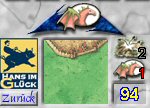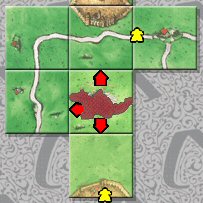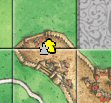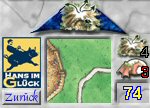Carcassonne Burgfräulein und Drache
The Game
The third expansion of Carcassonne "Burgfräulein und Drache" is known in Dutch as "De Draak, de Fee en de Jonkvrouw". It too is now available to play on BrettspielWelt. It includes 30 new tiles that create volcanoes, you meet dragons and fairies, and there are magical gates to discover.
You can also play this expansion together with the first expansion, as well as with Merchants and Builders and with the "mini-expansions" The River and King and Explorer.
The new parts
Landscape tiles

The street is not interrupted by the tunnel. Also, the two meadows each to the left and right of the street are connected at the entrances to the tunnel and each count as one meadow.

With the monastery in the city, you have the choice of putting a token on the monastery or in the city. If you put it in the city, it will be scored when the city is completed. However, if you place it on the monastery, it is scored when the eight surrounding tiles have been placed, just like a normal monastery. It does not matter then whether the city is finished or not.
You can also place a token in the monastery if there are already knights in the surrounding city. Conversely, a knight can be placed in the city on the next turn if only the monastery is occupied.
Joness

If you draw a tile with a damsel on it, you lay it according to the rules and may place a token on it.
Exception:If you place the tile in a town that already has one or more knights on it, you must remove one of the knights present and return it to its owner. To do this, click on the token to be removed. You may then not place a token on the tile created!
Dragon

If you draw a volcano then you lay it out in the normal way. However, you may then not place a game figure on it! Instead, the dragon will be placed on this tile. .

If you draw a tile with a dragon on it, you may place it as normal. You may then also place a token on top of it.
Next it's the dragon's turn now! It is moved around the board by the players. Starting with the player whose turn it is, all players must take turns moving the dragon one tile horizontally or vertically. The possible directions are shown by the red arrows. To move the dragon, click on the tile where it is going.
The dragon is always moved exactly six tiles, regardless of the number of players in the game. The number of remaining moves is shown at the top right of the dragon's symbol.
The dragon may never enter a tile twice, and the tile on which the fairy stands is taboo. If the dragon lands on a dead point (there are no more valid directions to move) then the remaining moves expire. If the dragon lands on a tile where there is a token then it is taken off the board and goes back to its owner. After moving the dragon the game continues in the normal way.
If a tile is drawn before the dragon is in play (due to a volcano card) with a dragon on it, then this tile is set aside and a new tile is drawn. Once the dragon comes into play with a volcano tile then the set aside tiles are reshuffled with the draw pile.
The fairy comes into play when a player does not place a token during his turn. Each time someone does not place a token, they may place (or move to) the fairy on any tile on which they already have a token. To do this, click on the token you want the fairy to be placed next to.
The fairy has three properties:
If you draw a tile with a magic gate on it, you may place a playing piece either on this tile or on any other tile on the board. In doing so, the rules for placing playing figures are still in effect (no playing figure may be placed in an area where there is already a figure) and no playing figure may be placed in an area that is already scored.
If you want to place a token on a tile other than the one you just created, click on the desired tile. Small squares are then displayed there with the valid moves. Then click on the square where you want to place a token.
The number of tiles with dragons and magic gates already drawn is displayed to the right of the tile just drawn.


Fairy

Magic gate

Division of tiles.

